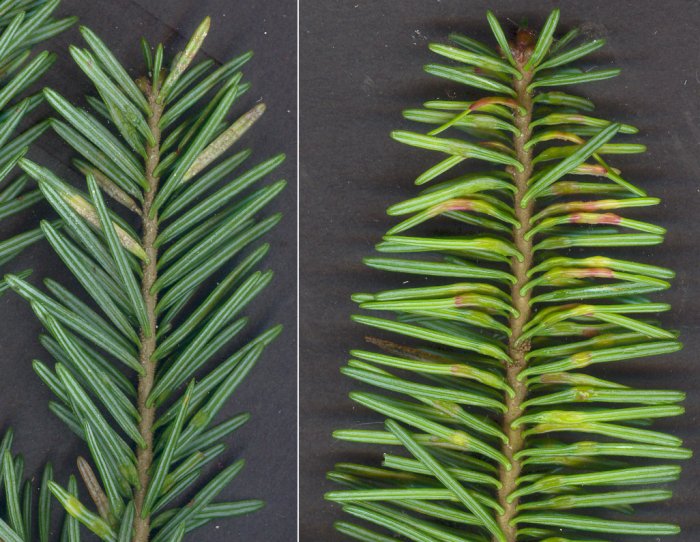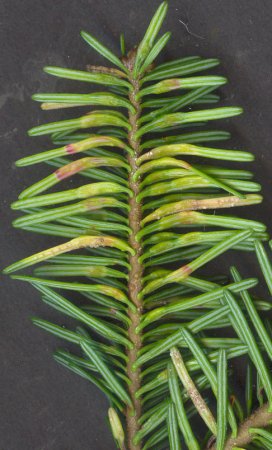Essays >> Life and Death on a Fir needle
LIFE AND DEATH ON A FIR NEEDLE

The picture at near right shows a current-year's branch of balsam fir with four needles colonized by the rust fungus Uredinopsis americana. Although these were photographed in mid-August, rather late in the season for this rust, the colonized needles can be recognized by their yellowish colour and small blister-like spots. The branch at far right has quite a different appearance. Here some of the needles have discoloured swellings that are clearly not just rust infections. These swellings are in fact not even caused by fungi but are the product of gall midges, tiny flies that have finely-tuned relationships with plants. In spring the balsam fir gall midge Paradiplosis tumifex lays its eggs on the developing needles of the current season's growth, along with a chemical substance that causes the needle to form a gall surrounding the egg. When the egg hatches the larva will eat the tissue of the gall until it reaches full size and then pupate. The needle will eventually fall to the ground, pupa included, where it will become covered by protective winter snow. In the spring the adult midge will emerge from the pupa, mate and lay its fertilized eggs on the new fir needles, thus completing a full life cycle.
Life may not be entirely satisfactory for Paradiplosis tumifex. Another gall midge Dasineura balsamicola also feeds on balsam fir galls but lacks the chemicals necessary to create its own. Instead it lays its egg beside those of P. tumifex in such a way that they also will become enclosed by the gall. When these eggs hatch the larvae also will begin to consume the gall tissues and will eventually cause the death of P. tumifex. Dasineura balsamicola is what biologists call an inquiline, an animal that lives within the dwelling of another, often harmlessly but frequently also competitively so that the host is at a disadvantage. Both of these gall midges are common on needles of balsam fir. If you break one of these galls open you may find either, or occasionally both, of these larvae.

Paradiplosis tumifex and Dasineura balsamicola may be locked in a one-sided competition but they also have external enemies to contend with. There are several species of Hymenoptera, tiny wasps, that target both gall midges as food for their own larvae. These wasps have elongated ovipositors that pierce the galls and lay eggs on the larvae of the gall midges. When these eggs hatch the wasp larvae begin the feed on the living gall midge larvae until they are entirely consumed. In spring the fallen needles will not yield emerging gall midges, but tiny wasps.
And now back to the fungi. The picture at left shows the now familiar rusts and midge galls but this time they are together on the same needle. Research by Drs. D.R. Bergdahl and M. Mazzola at the University of Vermont has shown that when Uredinopsis americana develops on needles bearing midge galls the larvae do not survive, perhaps because of fungal toxins. This sounds like a potential source of biological control of gall midges on balsam fir, until you realize that the gall midge is not a serious pest to the tree because it only occurs on the current season's growth and also because the rust itself causes the needles to drop prematurely just as those with midge galls do. In this case it is best, as it often is, to let nature take its course.